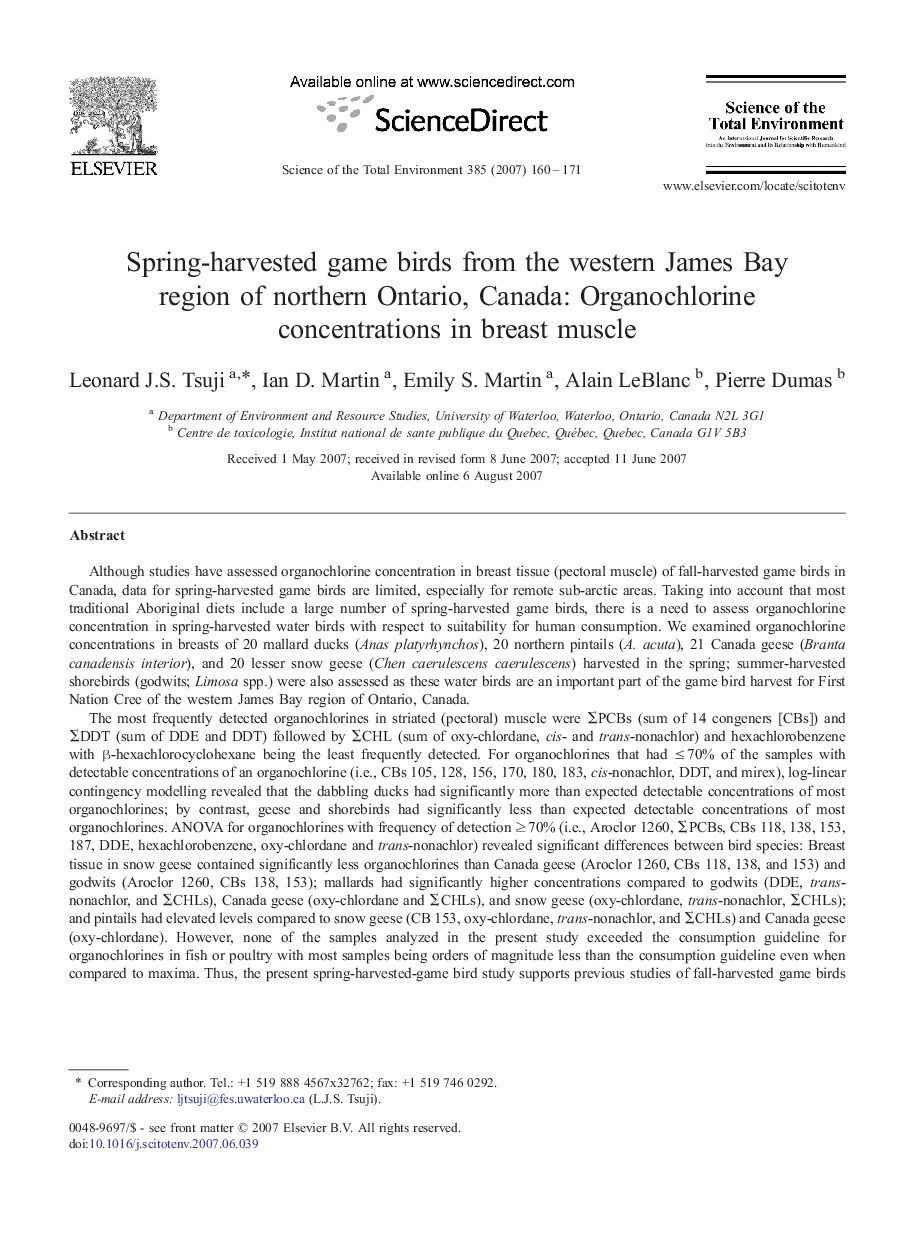| کد مقاله | کد نشریه | سال انتشار | مقاله انگلیسی | نسخه تمام متن |
|---|---|---|---|---|
| 4432799 | 1619942 | 2007 | 12 صفحه PDF | دانلود رایگان |

Although studies have assessed organochlorine concentration in breast tissue (pectoral muscle) of fall-harvested game birds in Canada, data for spring-harvested game birds are limited, especially for remote sub-arctic areas. Taking into account that most traditional Aboriginal diets include a large number of spring-harvested game birds, there is a need to assess organochlorine concentration in spring-harvested water birds with respect to suitability for human consumption. We examined organochlorine concentrations in breasts of 20 mallard ducks (Anas platyrhynchos), 20 northern pintails (A. acuta), 21 Canada geese (Branta canadensis interior), and 20 lesser snow geese (Chen caerulescens caerulescens) harvested in the spring; summer-harvested shorebirds (godwits; Limosa spp.) were also assessed as these water birds are an important part of the game bird harvest for First Nation Cree of the western James Bay region of Ontario, Canada.The most frequently detected organochlorines in striated (pectoral) muscle were ΣPCBs (sum of 14 congeners [CBs]) and ΣDDT (sum of DDE and DDT) followed by ΣCHL (sum of oxy-chlordane, cis- and trans-nonachlor) and hexachlorobenzene with β-hexachlorocyclohexane being the least frequently detected. For organochlorines that had ≤ 70% of the samples with detectable concentrations of an organochlorine (i.e., CBs 105, 128, 156, 170, 180, 183, cis-nonachlor, DDT, and mirex), log-linear contingency modelling revealed that the dabbling ducks had significantly more than expected detectable concentrations of most organochlorines; by contrast, geese and shorebirds had significantly less than expected detectable concentrations of most organochlorines. ANOVA for organochlorines with frequency of detection ≥ 70% (i.e., Aroclor 1260, ΣPCBs, CBs 118, 138, 153, 187, DDE, hexachlorobenzene, oxy-chlordane and trans-nonachlor) revealed significant differences between bird species: Breast tissue in snow geese contained significantly less organochlorines than Canada geese (Aroclor 1260, CBs 118, 138, and 153) and godwits (Aroclor 1260, CBs 138, 153); mallards had significantly higher concentrations compared to godwits (DDE, trans-nonachlor, and ΣCHLs), Canada geese (oxy-chlordane and ΣCHLs), and snow geese (oxy-chlordane, trans-nonachlor, ΣCHLs); and pintails had elevated levels compared to snow geese (CB 153, oxy-chlordane, trans-nonachlor, and ΣCHLs) and Canada geese (oxy-chlordane). However, none of the samples analyzed in the present study exceeded the consumption guideline for organochlorines in fish or poultry with most samples being orders of magnitude less than the consumption guideline even when compared to maxima. Thus, the present spring-harvested-game bird study supports previous studies of fall-harvested game birds that contend that pectoral muscle portions are safe to eat. Nevertheless, skin and fat associated with the breast muscle may be another matter.
Journal: Science of The Total Environment - Volume 385, Issues 1–3, 15 October 2007, Pages 160–171